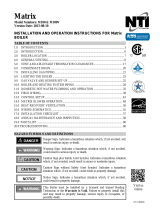
CI2 Exhaust Vacuum Relief Damper Installation
6176 047 - 02
4
Safety
Important Regulatory and Installation Requirements
Approvals
Viessmann boilers, burners and controls are approved for
sale in North America by CSA International.
Codes
The installation of this unit shall be in accordance with
local codes. In the absence of local codes, use:
- CSA C22.1 Part 1 and/or local codes in Canada
- National Electrical Code ANSI/NFPA 70 in the U.S.
Always use latest editions of codes.
The heating contractor must comply with the Standard
for Controls and Safety Devices for Automatically Fired
Boilers, ANSI/ASME CSD-1 where required by the
authority having jurisdiction.
Working on the equipment
The installation, adjustment, service, and maintenance
of this product must be done by a licensed professional
heating contractor who is qualified and experienced in the
installation, service, and maintenance of hot water boilers.
There are no user serviceable parts on the boiler, burner,
or control.
Power supply
Install power supply in accordance with the regulations
of the authorities having jurisdiction or, in absence of
such requirements, in accordance with National Codes.
Viessmann recommends the installation of a disconnect
switch to the 120V power supply outside of the boiler
room.
Ensure main power supply to equipment, the heating
system, and all external controls have been deactivated.
Close main oil or gas supply valve. Take precautions in
both instances to avoid accidental activation of power
during service work.
Please carefully read this manual prior to attempting
installation. Any warranty is null and void if these
instructions are not followed.
For information regarding other Viessmann System
Technology componentry, please reference
documentation of the respective product.
We offer frequent installation and service seminars
to familiarize our partners with our products. Please
inquire.
The completeness and functionality of field supplied
electrical controls and components must be verified
by the heating contractor. These include low water
cut-offs, flow switches (if used), staging controls,
pumps, motorized valves, air vents, thermostats, etc.
WARNING
Turn off electric power supply before
servicing. Contact with live electric
components can cause shock or loss
of life.
For installations on the Commonwealth of Massachusetts, the following modifications to NFPA-54 chapter 10 apply:
Excerpt from 248 CMR 5-08:
2(a) For all side-wall horizontally vented gas fueled equipment installed in every dwelling, building or structure used
in whole or in part for residential purposes, including those owned or operated by the Commonwealth and where
the side-wall exhaust vent termination is less than (7) feet above finished grade in the area of the venting,
including but not limited to decks and porches, the following requirements shall be satisfied:
1. INSTALLATION OF CARBON MONOXIDE DETECTORS. At the time of installation of the side-wall horizontal
vented gas fueled equipment, the installing plumber or gas fitter shall observe that a hard wired carbon
monoxide detector with an alarm and battery back-up is installed on the floor level where the gas equipment
is to be installed. In addition, the installing plumber or gas fitter shall observe that a battery operated or hard
wired carbon monoxide detector with an alarm is installed on each additional level of the dwelling, building or
structure served by the side-wall horizontal vented gas fueled equipment. It shall be the responsibility of the
property owner to secure the services of qualified licensed professional for the installation of hard-wired
carbon monoxide detectors.
a. In the event that the side-wall horizontally vented gas fueled equipment is installed in a crawl space or an
attic, the hard-wired carbon monoxide detector with alarm and battery back-up may be installed on the next
adjacent floor level.
b. In the event that the requirements of this subdivision can not be met at the time of completion of installation,
the owner shall have a period of thirty (30) days to comply with the above requirements; provided, however,
that during said thirty (30) day period, a battery operated carbon monoxide detector with an alarm shall
be installed.
















